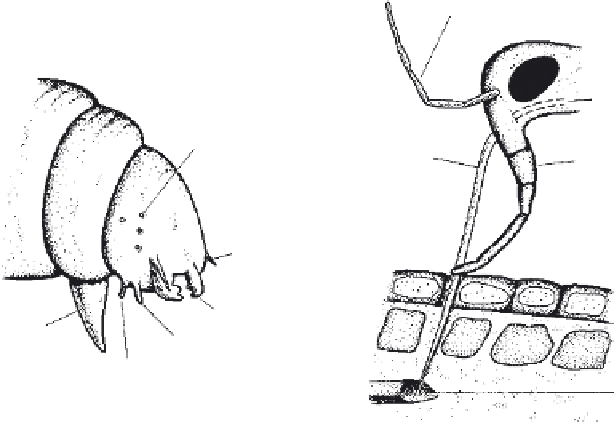Agriculture Reference
In-Depth Information
This development method is called
incomplete
metamorphosis
. In contrast, in the second group
of insects (
Endopterygota
), including the moths,
butterflies, flies, beetles and sawflies, the grubs
(larvae) undergo a remarkable change (
complete
metamorphosis
) within the pupa. The egg hatches
to form a first
instar
, called a
larva
, which usually
differs greatly in shape from the adult. For example,
the larva (caterpillar) of the cabbage white bears little
resemblance to the adult butterfly.
Some damaging larval stages are shown in Figure
18.10 and these can be compared with the often more
familiar adult stage.
The method of
overwintering
differs between
insect groups. The aphids survive mainly as the eggs,
while most moths, butterflies and flies survive as the
pupa. The speed of increase of insects varies greatly
between groups. Aphids may take as little as 20 days
to complete a life cycle in summer, often resulting
in vast numbers in the period June to September.
However, the wireworm, the larva of the click beetle,
usually takes four years to complete its life cycle.
Insect groups are classified into their appropriate order
(Table 18.1) according to their general appearance and
life-cycle stages.
reader should also refer to Chapter 16 for details of
specific types of control (biological, chemical, cultural
and so on) and for explanations of terms used.
Aphids and their relatives (
order
Hemiptera
)
This important group of insects has the egg-nymph-
adult life cycle (see Exopterygota, p. 228) and sucking
mouthparts.
Peach-potato aphid (
Myzus persicae
)
Damage
.
The species commonly occurs in
greenhouses and outdoors in hot summers. The
adult and nymph stages of this pest may cause three
types of damage. First, using the sucking stylet (see
Figure 18.8), it may inject a digestive juice into the
plant phloem, which, in the sensitive tissues of buds
may lead to distortion. Second, having sucked up
sugary phloem contents, the aphid excretes a sticky
substance called honeydew that may block leaf
stomata and reduce photosynthesis, particularly when
dark-coloured fungi (
sooty moulds
) grow over the
honeydew. Third, the aphid stylet may suck up and
then transmit viruses such as severe mosaic virus and
leaf roll virus (see p. 262) on potato.
Life cycle
. This aphid varies in colour from light
green to orange, measures 3 mm in length (see
Figure 18.11a), and has a complex life cycle, shown
in Figure 18.12, alternating between the winter
host (peach) and the many summer hosts such as
potato and bedding plants. In spring and summer,
Insect pests
There follows now a selection of insect pests in which
each species' particular features of life cycle are given.
While comments on control are mentioned here, the
Antenna
Intestine
Ocelli
(primitive eyes)
Stylet
Rostrum
Antenna
Mandible
Front
leg
Maxilla
Labium
Caterpillar
Leaf
phloem
Aphid
Figure 18.8
Mouthparts of the caterpillar and aphid. Note the different methods of obtaining nutrients. The
aphid selectively sucks up dilute sugar solution from the phloem tissue



















